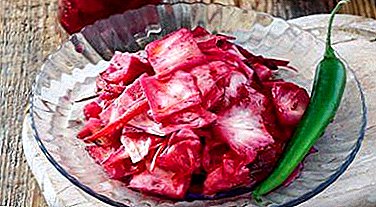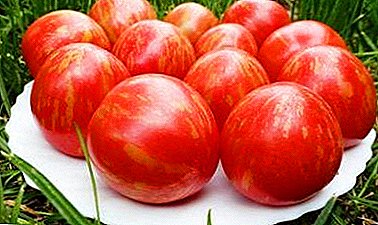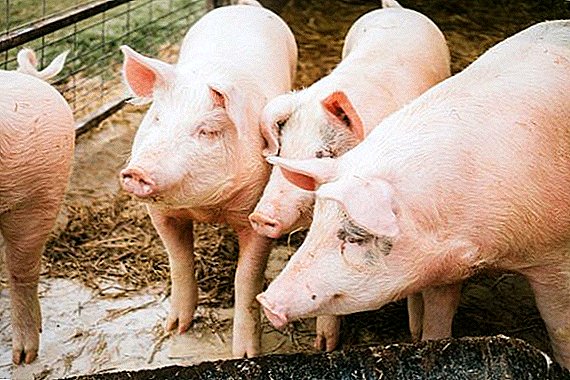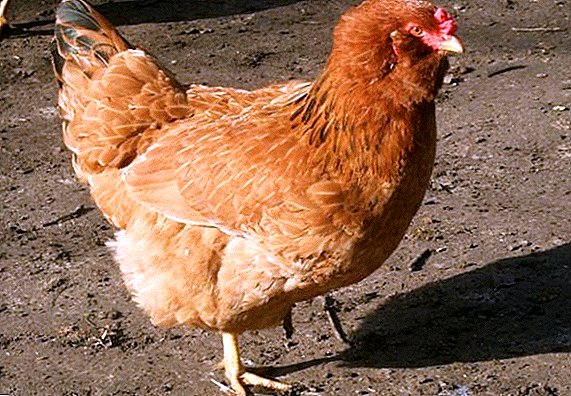 If you intend to start chickens in your farm, but have never had experience in caring for such birds before, we recommend you to pay attention to such a breed as "Ukrainian lohmonogaya Ushanka".
If you intend to start chickens in your farm, but have never had experience in caring for such birds before, we recommend you to pay attention to such a breed as "Ukrainian lohmonogaya Ushanka".
In this article you will find all the necessary information about this breed of birds: how they look, what conditions they need to be maintained and how to properly and productively breed them.
History reference
It is not known for certain how this breed was bred, but, according to evidence obtained from an analysis of historical essays, it can be said that chickens with a similar exterior have been in great demand in Russia and Ukraine since the 17th century. Judging by the external parameters, the primary purpose (egg-bearing breed) and character, initially this breed was obtained as a result of the interbreeding of white Russian and leggorn breeds.
Did you know? Evidence of the first domesticated hens were discovered during excavations on the territory of modern Ethiopia. According to them, the first domestic chickens appeared about 3 thousand years ago.
Despite the obvious similarity in external characters, there is a very strong correlation between the name of the breed and the locality where it was bred. For example, birds similar in all external parameters and productivity are also known as South Russian, Little Russian and Russian.  Such confusion in the name is primarily due to the fact that this breed belongs to the national (autochthonous), which automatically cancels all attempts to include it in any registries.
Such confusion in the name is primarily due to the fact that this breed belongs to the national (autochthonous), which automatically cancels all attempts to include it in any registries.
Ukrainian Ushanka is included in the ranking of the best hens of egg breed. Among the hens of the egg direction are also distinguished breed Leggorn, Loman Brown, Russian White, Orlovskaya, Pavlovskaya, Minorka.
Characteristics and features
If you are planning to breed these birds, you should definitely get acquainted with their distinctive features. This will be useful, at a minimum, so that when you buy chicks or adults you are not deceived by an unscrupulous seller. Below you will find a description of all the external characteristics and behavioral characteristics of these birds.
Appearance
The main distinctive feature of the earflaps is the small size of the skull, on which the frontal bone is especially prominent. The front of the head and earlobes are often colored scarlet or pale red. On top of the skull is a leaf-shaped or rosy-shaped comb, in red. The ear lobes are covered with rather thick “whiskers” made of feathers, and a “beard” is placed under the beak.
Beak - quite powerful, strong, has a slight bend. Neck - the average length, systematically goes into a rounded wide chest. The back has a pronounced bend, rather wide, with underdeveloped wings, densely covered with feathers. In general, we can say that the body of this breed of hens is rather oblong and dense. 
Did you know? In the wild or when there is a shortage of food, chickens can eat their own damaged eggs.
The legs are not covered with feathers, most often pink or whitish, placed in the lowest part of the body. Each foot ends with 4 fingers, 3 of which are used to form the foot, and 1 is opposing, helping the bird to keep balance. The earflaps have a developed tail, especially pronounced in roosters. Feathers evenly cover the whole body with a dense, thick layer.
Color
Ushanka feathers often have a black tint, less often red-brown. It is also possible pockmarked colors with spots of white, red, brown, black, yellow colors, depending on the main colors. Some specimens have a white color, but such individuals are not so easy to find. The ear-flaps with a white color are direct descendants of their former "parents", and those that have a different coloring are formed as a result of subsequent crosses of different breeds with each other. 
Character
In general, this breed of birds has a fairly peaceful and calm nature, however, under certain conditions (stress in conditions of overcrowding in the house, lack of proteins, methionine and / or some trace elements), cannibalism is possible. Most often, the victims are those individuals that were injured or have a noticeable physical defect.
Earflaps prefer to be in the pack, rarely beat off from their brethren, eat and drink water all together, especially in the period after the birth of chickens. They do not like neighborhoods with other animals and birds, preferring the company of their own kind to any other. They get along badly with various domestic animals (dogs, cats). A large flock of these birds in conditions of lack of space may begin to show aggression towards other animals, and sometimes to humans.
Hatching instinct
The hens of this breed have a very pronounced and resistant maternal instinct. They take a very responsible approach to incubating egg clutches, trying once again not to be distracted even by food and drink, and after the chicks hatch, they don’t leave them almost a step away, which gives the farmers terrific reproduction rates.
Learn how to choose a hen hen and how to get young by naturally incubating eggs.

Important! Chickens of this breed are also well and eager to start hatching duck and goose eggs. However, after the chicks hatch, the hen needs to be urgently weaned from them, since there is a high probability that, upon seeing the substitution, she will kill them.
Productive qualities
Speaking about the productivity of these chickens for your farm, you need to immediately understand what earflaps are a purely egg-bearing breed. They are not distinguished by a rapid gain in weight and high palatability, like broilers or coquins, and they do not even combine in themselves the strengths of meat breeds and egg yachts, like marketolies or amroxes.
Nevertheless, they do quite well with their main purpose - carrying eggs, and the excellent maternal instinct makes it easy to reproduce them, actively increasing their productivity indicators. In more detail about the productive qualities of Ukrainian fur hat you can read below.
Puberty and annual egg production
The term of puberty is one of the most significant drawbacks of this breed. The first laying of eggs a young hen can carry only by the 6th month of his life. This makes them rather bad candidates for breeding in the conditions of large industrial farms, where in a short time you need to get a huge number of eggs.
It is useful to know which vitamins are necessary for laying hens and why chickens do not carry eggs.
 The average annual egg production of these birds occupies an intermediate position between the overproductive egg hens (for example, leggorn) and meat and egg. On average, one year after the onset of puberty, the Ushanka can carry 150-170 eggs, but this figure drops as they age. Eggs most often have a white shell and a weight in the region of 50-60 g.
The average annual egg production of these birds occupies an intermediate position between the overproductive egg hens (for example, leggorn) and meat and egg. On average, one year after the onset of puberty, the Ushanka can carry 150-170 eggs, but this figure drops as they age. Eggs most often have a white shell and a weight in the region of 50-60 g.
Precocity and taste of meat
Ushanka reach its maximum weight by the 5-6th month after hatching from the egg. For roosters, it is about 3 kg, and for chickens it fluctuates around 2-2.5 kg. In some cases, especially if vitamin-mineral supplements are added to feed from an early age, these chickens can reach maximum weight by the 4th month of life.
To get high-quality meat, you should breed such breeds: Brama, Jersey Giant, Cochinhin, Orpington, Faverol.
Although, in terms of taste and quantitative indicators, the meat of these chickens is significantly inferior to meat breeds, nevertheless, it is quite edible, has an average degree of rigidity and is quite fatty. The loin and thighs are quite juicy, fat, practically have no veins inside, the wings are slightly dry and harsh. 
Important! Meat with earflaps is great for boiling broth out of it, because it combines muscular and adipose tissue in perfect proportions.
Conditions of detention
Ukrainian fur hat does not require any special conditions for its content, and in general, caring for them is not much different from caring for any other breed of hens. Nevertheless, there are some special aspects that will help you to significantly reduce the cost of maintaining them and still allow you to extract the maximum benefit from it.
Coop Requirements
The chicken coop must be large enough so that, if desired, each of the birds in the flock can find a place on the pole, perch, nest or on the floor. If you notice that the chickens do not have enough space in the room, additionally equip it with several horizontal poles, to which lead a light wooden staircase. The number of perches should be equal to the number of chickens incubating the next generation of chickens, and the number of nests should be 1/3 of the total number of birds.  It is desirable that the floor in the chicken coop was wooden, this will avoid injuries and frostbite of chicken legs during the cold season. If the floor in the room is concrete or stone - try to cover it with bedding or oilcloth. The litter should consist of hay, straw or sawdust. The temperature in the chicken coop should not be lower than + 15 ... +20 ° С, first of all for the normal life of the chickens.
It is desirable that the floor in the chicken coop was wooden, this will avoid injuries and frostbite of chicken legs during the cold season. If the floor in the room is concrete or stone - try to cover it with bedding or oilcloth. The litter should consist of hay, straw or sawdust. The temperature in the chicken coop should not be lower than + 15 ... +20 ° С, first of all for the normal life of the chickens.
It is important to equip the room with adequate lighting, since chickens are carried only in the light, even if the egg is already fully formed. In the warm season, the litter changes 2 times a month, and if you don’t pack it, you can limit yourself to cleaning the waste once a month. In the cold season, the litter will need to be changed 2 times a week in order to prevent the development of a variety of bacterial diseases in your chickens.
Important! To protect your chicken coop from night invasions of rats and / or other predators, carefully monitor the appearance of various openings and crevices on the floor, walls or ceiling. If such defects appear, immediately pour poison on them for rats and fill them with cement or concrete.
Walking yard
Ear flaps do not require very large walking spaces, usually a flock of 10-15 hens is enough to have a yard measuring 3 × 4 m. Be sure to take care of the presence of a fence at least 1.5 m high, as with age almost all roosters and some chickens start try to fly and successfully get over through low fences.  The courtyard should give your birds the opportunity to dig in the ground in search of worms and / or grass, so it should not have sex. If you live in an area inhabited by a large number of ravens, hawks or eagles, it is recommended to cover the courtyards for walking birds with a sloping roof.
The courtyard should give your birds the opportunity to dig in the ground in search of worms and / or grass, so it should not have sex. If you live in an area inhabited by a large number of ravens, hawks or eagles, it is recommended to cover the courtyards for walking birds with a sloping roof.
Feeders and drinkers
Feeders and drinkers should be just enough so that each bird at the time of the simultaneous meal with all the congeners could find a place near them. To do this, it is recommended to place these devices strictly in the middle of the courtyards and at least 50-70 cm away from each other. For a flock of 10-15 birds, usually 2 feeding troughs and 2 drinking bowls are usually enough.
Learn how to build feeders and drinkers for chickens with their own hands.
How to endure cold and heat
Ukrainian Ushanka is a breed that can be grown in almost any latitude, even in the coldest climate. Her long and thick plumage allows her to easily endure even the most severe frosts. Nevertheless, she has rather tender legs, therefore, as already mentioned, it is better to lay litter in the hen house during the cold season.
The heat is perceived by these birds as a whole is no worse than the cold. Certain difficulties can be experienced only by individuals with black plumage, since it absorbs more sunlight and, accordingly, such birds overheat more during strong heat. Therefore, chickens with black feathers are better not to let out during periods of pronounced solar activity. 
Moult
Often the molt at fur hat occurs at the end of autumn - the beginning of winter, and, as a rule, it almost completely stops the process of laying eggs. This phenomenon is primarily due to the fact that during the molt the bird's body requires a large number of macronutrients, in particular calcium and phosphorus, which normally go to the formation of eggshell. Molting in adult chickens is an annual event that is largely due to the lack of natural light.
The process of molting begins from the neck and head and gradually spreads down through the torso, wings and back to the tail. In the process of molting, the chickens' body becomes very sensitive to various external stimuli due to the fact that at the time of the feathering of the feathers, the thin blood vessels passing under the skin are damaged. That is why it is not recommended to pick up chickens on your hands during molting. The whole process lasts on average from 1 to 3 months.
Important! To speed up the completion of the molting process, it is recommended to give chickens in autumn and winter as much feed as possible containing an increased amount of protein.
What to feed an adult flock
Proper diet is the key to successful breeding and high egg production rates. It is especially important to ensure that the hens receive a sufficient amount of proteins and macroelements, since they contribute to the normal processes of egg formation.  Here is a list of products that need to be included in the diet of adult Ukrainian fur cap:
Here is a list of products that need to be included in the diet of adult Ukrainian fur cap:
- clover flour;
- fish flour;
- boiled potatoes;
- chopped greens;
- cabbage;
- carrot;
- beet;
- grain crops (wheat, barley, etc.);
- legumes (lentils, beans, etc.);
- ground eggshell;
- yeast.
Familiarize yourself with the specialties of poultry feed preparation.
Breeding chicks
The survival rate of this breed reaches colossal marks. According to official data, 86% of chickens survive from each litter, and about 89% of chickens that have reached one month of age survive. Practice shows that with adequate conditions of detention, these figures become even higher. Below you will find information on how to properly organize the breeding of chicks of this breed.
Hatching eggs
The hen is on average capable of sitting in 1 laying about 10-15 eggs, however, variations of these figures in both directions are possible, depending on how much the plumage and large size the chicken has. Roost is best to equip in the farthest corner of the chicken coop, blocking it with boards or building a brick partition.  Next to the perch nest, it is necessary to put a feeding trough and watering for the mother so that she does not have to move far from her future offspring and she, in case of such a need, could quickly respond to attacks on her eggs of other birds or predators. The incubation process continues on average about 19-21 days.
Next to the perch nest, it is necessary to put a feeding trough and watering for the mother so that she does not have to move far from her future offspring and she, in case of such a need, could quickly respond to attacks on her eggs of other birds or predators. The incubation process continues on average about 19-21 days.
Care for the young
As already mentioned, the Ukrainian Ushanka is a magnificent mother, therefore, as such, there should be no need to care for the young. Nevertheless, you should make sure in advance that the chicks, after their hatching, do not come into contact with other adult birds, except for their hen, since they may begin to peck until the death occurs.
Try to arrange a space for the young, completely enclosed on all sides, even from above, since very often small chicks become victims of birds of prey. Calculate the required number of feeders and drinkers in advance and carefully consider their location. Try to arrange for the chicks and their mother a walking yard with access to fresh grass.
Chicken Diet
 Chickens have a fairly gentle digestive tract, so do not immediately begin to feed them as adult chickens. In the first week it is recommended to give them only millet or crushed grain. Starting from the second week, gradually expand the diet, adding boiled vegetables and eggs, bran, bone meal, greens and yeast to it. When the chickens have reached the age of 3 months, you can start feeding them with the same diet as other birds.
Chickens have a fairly gentle digestive tract, so do not immediately begin to feed them as adult chickens. In the first week it is recommended to give them only millet or crushed grain. Starting from the second week, gradually expand the diet, adding boiled vegetables and eggs, bran, bone meal, greens and yeast to it. When the chickens have reached the age of 3 months, you can start feeding them with the same diet as other birds.
Pros and cons of breed
The advantages of this breed include:
- unpretentiousness to temperature conditions;
- high survival rate of chicks and adult birds;
- undemanding to the size of the pleasure yard;
- extremely well developed maternal instinct;
- quite good egg production;
- unpretentiousness in food;
- In addition to eggs, it also gives good meat.
- small weight of individuals;
- small size and weight of eggs;
- quite sensitive legs;
- late time of puberty;
- the development of cannibalism in response to certain environmental factors;
- hard to tolerate the molting period.
So, we hope that this article has helped you find answers to all your questions about such a breed of hens as the Ukrainian Ushanka. And if you do not just treat the breeding of these birds as a way of making money, but try to approach them with soul and invention, you will end up with a lot of fun. Good luck to you in this difficult matter!
Reviews
Of course, if you keep a herd of people like in the Moscow population, it will become boring ... But these! But you need to see what happens.













